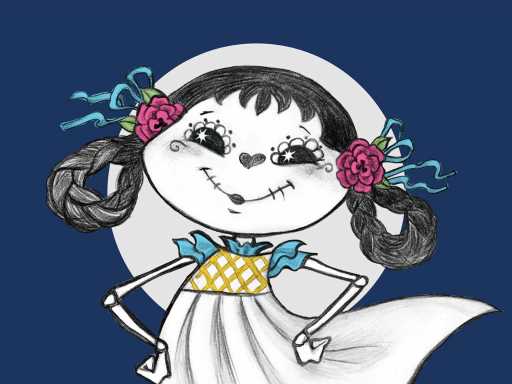Nightmares have finally met a formidable match. Her name is Skeletina and she’s on a mission to help kids enjoy their kookiest, spookiest dreams. Created by author and illustrator Susie Jaramillo, the co-founder of Encantos, an entertainment edtech company, Skeletina is all about being fearless, brave and empathetic. Bonus points for bilingual families: her story is available in English and Spanish!
Readers can follow Skeletina’s adventures in the new picture book Skeletina and the In-Between World, as she, along with some of her undead friends, teaches kids to face their biggest fears. SheKnows chatted with Jaramillo all about the art of conquering nightmares, writing beloved bilingual stories and the best ways to empower kids to speak Spanish.
SheKnows: How was the idea for Skeletina born?
Susie Jaramillo: I was raised very Catholic. I had really bad nightmares because there’s all this guilt about Heaven and Hell. I would go to my mom and my mom would just say, “Did you do something bad? Do you have something to be guilty about? Okay, then go back to bed.”
One day, I decided I was going to give in. I had a lot of flood dreams, and I thought, I’m just going to let myself drown to see what happens. And then, I realized that I could still breathe! I could breathe underwater. I [thought], “Oh my god, this just changed everything, this concept of surrendering to the forces in your dreams.’”
My daughter has gone through the same things I did, she struggled with her nightmares. That’s when it occurred to me: “I wish there was a friend inside of her dreams who could help her so that she doesn’t have to be afraid of all these crazy things.”
Can you take me through the visual elements of designing Skeletina?
SJ: I’ve always been charmed by Pippi Longstocking and Raggedy Ann, and I’ve always been a Tim Burton fan. I’ve never seen any Latin culture in that world until Coco… and Coco didn’t really have any strong female characters. I wanted that independent female lead who had a rag doll quality and was really irreverent, blunt, funny and broke all the rules without meaning to.
It’s a tricky subject, nightmares. I think this type of story helps children see that, [they’re not alone}. Shining a light on the fears and turning the fears into a monster that can be diffused is the magic.
You’ve described bilingual children’s books as a bit “cumbersome” in the past, and I’m curious how Encantos is reinventing that format?
(Jaramillo held up one of her books for reference while she spoke. As opposed to the typical bilingual book, which features both languages on the same page, Encantos books are printed with the English story on the front and, when you flip the book around, the Spanish version on the back.)
SJ: It’s one language at a time. I love this format, especially for early readers. The truth is, the human brain gets overwhelmed by clutter and lots and lots of extra words on the page is clutter.
Parents love it. Teachers love it. You’re throwing two languages at kids but throwing them in a way that is really easy to digest. And you’re capitalizing on their innate [desire] to want to read the book again and again and again.
You’ve created so many beloved songs through Canticos, your Latino-inspired bilingual nursery rhymes. What inspired you to write bilingual music?
SJ: We take a lot of pride in our music and in the different genres of Latin music that we put in. We want to make sure that adults love listening to it, [too]. We’re making it cool to speak Spanish, because the reality is everything cool is in English. So, here is this beautiful nursery rhyme Mother Goose world, where if you’re Argentine, Cuban, Mexican or Colombian, everybody sings Los Elefantitos or Los Pollitos
I like to say we make glue. Because it glues the community together. There’s a lot of situations where a grandma is Spanish dominant, barely speaks English and the kid barely speaks Spanish, but one thing they can do together is sing the songs. My kids don’t like to speak Spanish but you should see my daughter, so proud with the mic at my mother-in-law’s 50th anniversary, singing Los Pollitos in Spanish to a room full of Colombians in their 60s and 70s. She just lit up the room.
What advice would you give to parents who want to get their bilingual children excited about speaking Spanish?
SJ: Make it fun! Do not make it homework, do not make Spanish a source of strife. [Listening] to music in Spanish helps a lot. Reading…playing games. You’ve got to start super, super early, don’t wait until they’re in high school. Speak to them in Spanish all the time, crack jokes in Spanish and have fun with the way you speak Spanish.
Of course, if you can travel, go visit people who have Spanish dominant homes. Get them to see the culture firsthand so that they build and practice those skills.
This interview has been edited and condensed for clarity and length.
Before you go, check out some of our favorite children’s books starring boys of color.

Source: Read Full Article
